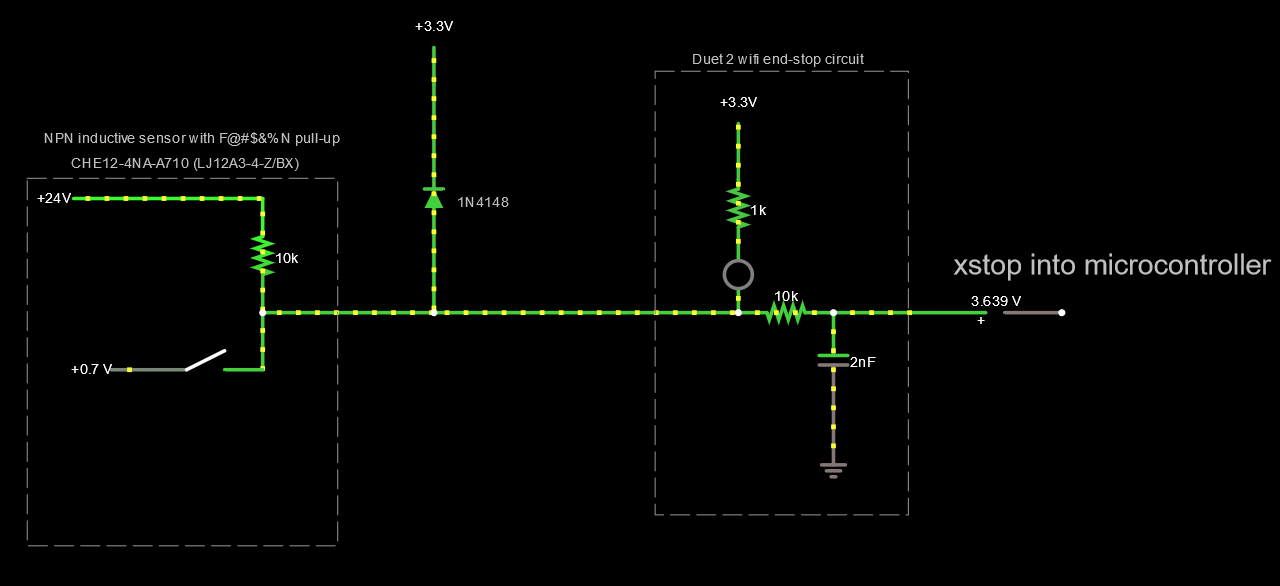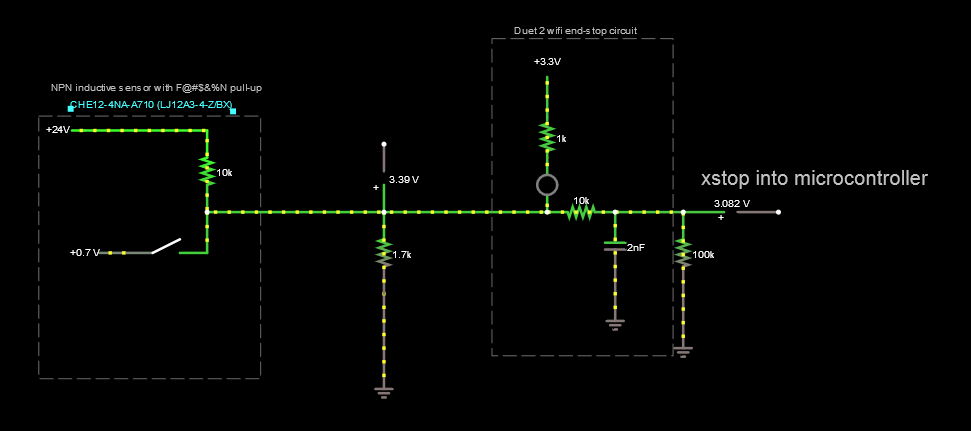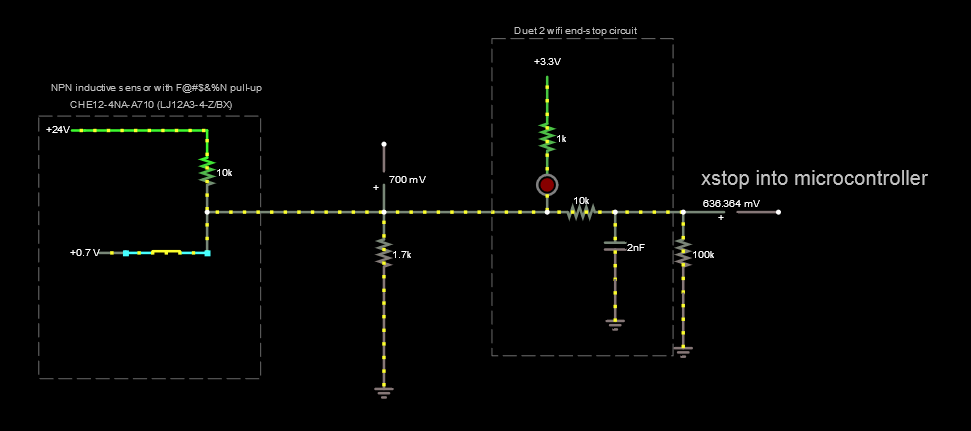Endstop LED lighting, but DWC does not show them triggered
-
Well if the output of the device only goes to 0.7 volts when you add in the voltage drop across the diode you added you are up to about 1.4 volts.
You measured 1.2 volts - so that is about right.
If 1.2 volts is too high then you may have to use the multiple diode approach I mentioned since this would allow pulling down the input to the 0.7 volts of the device while preventing the device from pulling up the input higher than 4 diode drops - or 2.8 volts. Three diodes might be enough if 2.1 volts is sufficient to deactivate the input.
Frederick
-
@Leav said in Endstop LED lighting, but DWC does not show them triggered:
*** Disconnected from the board they pull down the voltage to 0.7v!** holy moly this is the problem!
i doubt it, 0.7v across the NPN junction on the sensor is well below the logic threshold MIN [0.8V, 0.3 × VDDIO] for the input pin; but it does mean that adding a diode (another PN junction) adds another 0.7v which brings you over the threshold. Maybe a schotty diode would do the trick, but not alot of margins.
unfortunately quick google search doesn't yield a datasheet that shows a pull up resistor in the sensor so you'd probably have to measure the value of the pull up and design your voltage divider accordingly.
-
@bearer @fcwilt
What do you think of this setup? (proposed on reddit).
Is there any chance of damaging the 3.3v rail with a setup like this?
-
Hi,
Well I would not try that approach without hearing from dc42 first.
Perhaps the multiple diode approach seems a bit of a kludge but it is safe.
Do you know what the logic threshold voltages are for this Duet input. Normally a logic 0 would be specified as being below some fixed voltage and a logic 1 would be defined as being above some fixed voltage.
With a supply voltage of 3.3 it is possible that 2.1 (three diodes) would qualify as a logic 1.
So we are only talking about two additional diodes.
There is a type of diode called a zener which comes in different voltage ratings which could be used in your case to insure the input doesn't exceed a certain value.
I saw an assortment on Amazon that had numerous low voltage devices:
Chanzon 34 Values 0.5W Zener Diode Assorted Kit (2V 2.2V 2.4V 2.7V 3V 3.3V...) plus other much higher values. It was $7 for 34 diodes.
If you didn't mind using an LED they have different forward voltage drops depending on color. I believe I have a batch of white ones rated at 3 volts.
Frederick
-
@fcwilt said in Endstop LED lighting, but DWC does not show them triggered:
Do you know what the logic threshold voltages are for this Duet input.
@bearer said in Endstop LED lighting, but DWC does not show them triggered:
the logic threshold MIN [0.8V, 0.3 × VDDIO] for the input pin
(high side is MIN [2.0V, 0.7 × VDDIO])
-
@bearer said in Endstop LED lighting, but DWC does not show them triggered:
the logic threshold MIN [0.8V, 0.3 × VDDIO] for the input pin
Normally there would be two specs - one for a logic 0 and one for a logic 1.
Do you have a link to this info?
Thanks.
Frederick
-
-
-
Solved it! Thanks everyone for your help and guidance.
For posterity, I ended up using a pull down resistor of 1.7K, which balances the effects of:
- pull up in sensor
- pull up in Duet
-
@Leav said in Endstop LED lighting, but DWC does not show them triggered:
For posterity, I ended up using a pull down resistor of 1.7K
That is the standard way to use a PNP-output sensor. It's the same as for a Z probe (see https://duet3d.dozuki.com/Wiki/Connecting_a_Z_probe#Section_PNP_output_normally_open_inductive_or_capacitive_sensor) except that you need a lower value pulldown resistor, because of the pullup resistor in the Duet.
The output of an NPN sensor can be connected directly to the endstop input on all modern Duets, and should work that way.
-
@dc42 said in Endstop LED lighting, but DWC does not show them triggered:
The output of an NPN sensor can be connected directly to the endstop input on all modern Duets, and should work that way.
If I understand correctly, I think I have a very weird "NPN-ish" sensor, since it has a pull-up internally. connecting it directly would connect 24v to the 3.3v rail, which I understand is not a good thing, even with all the resistors in the way.



